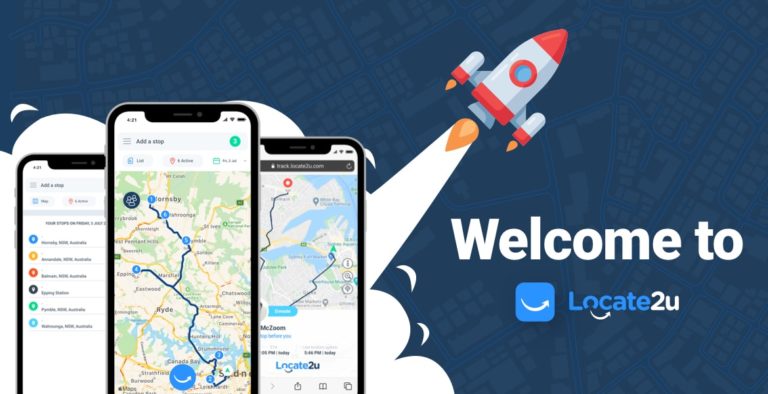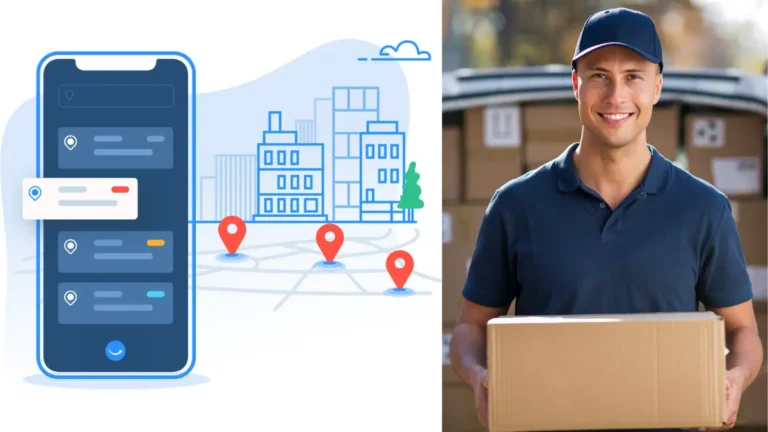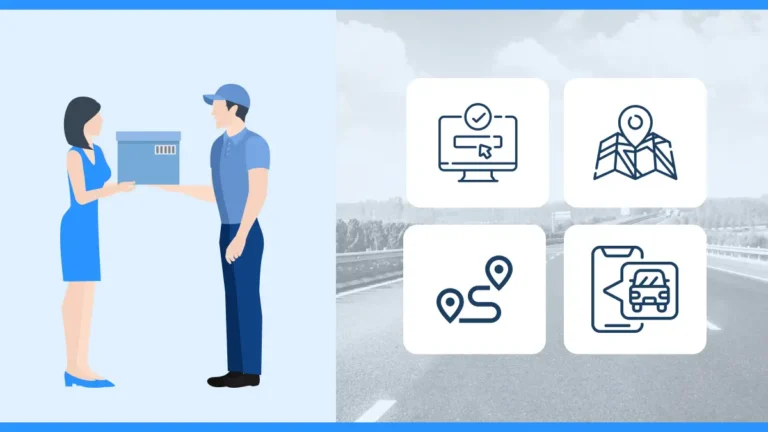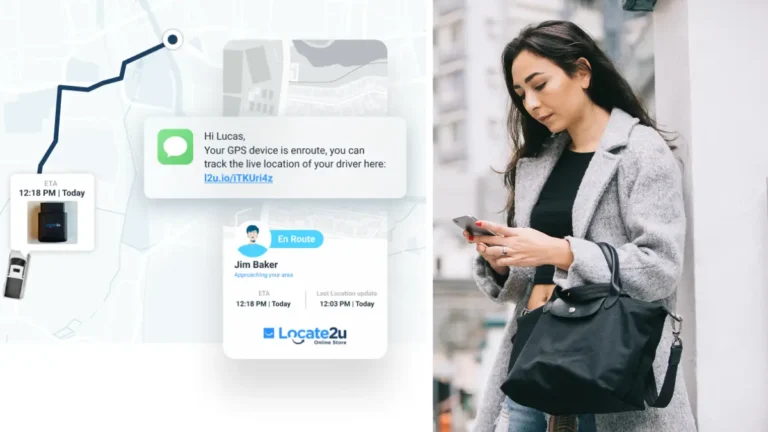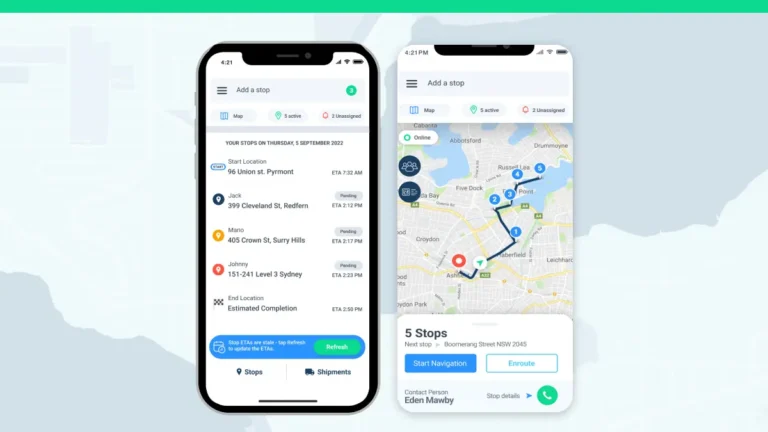If you own a restaurant, run a delivery company, or manage a logistics fleet, you’ve probably wrestled with the challenges of getting products delivered.
It’s a tough balancing act, isn’t it?
On one hand, you want to meet customer expectations, but on the other, you’re managing costs, time, and the complexity of operations.
This is where the concept of “dispatch and delivery planning” enters the picture. A dispatch management system is crucial in optimizing delivery operations and enhancing efficiency by providing real-time tracking, route optimization, and efficient resource allocation.
So, what exactly is dispatch and delivery planning, and why should it matter to you?
Understanding dispatch and delivery planning
In essence, dispatch and delivery planning is the backbone of efficient logistics and customer satisfaction.
It’s the strategy that ensures the right product reaches the right customer at the right time, while using the least amount of resources possible.
But it’s not just about scheduling trucks and drawing up delivery routes—it’s a complex process involving real-time decision-making, coordination, and optimization.
And for companies with a delivery fleet, whether you’re transporting gourmet food, custom furniture, or wholesale goods, dispatch and delivery planning can make or break your business.
Let’s take a look at this concept and explore why it’s not only crucial but also how delivery management software can take your operations from good to great.
We’ll also add in some scenarios to help you see how these processes unfold in real-world situations.
What are dispatch procedures?
Dispatch and delivery planning involves coordinating and scheduling the dispatch of vehicles to deliver goods or services. It’s a multifaceted process that includes route optimization, load planning, driver assignment, and real-time communication with your team and customers.
Imagine you own a furniture company. You’ve just received a massive order for custom-made sofas from a hotel across the state.
The delivery is scheduled for next week, but it’s not as simple as loading the sofas onto a truck and sending them off.
You need to consider factors like the shortest route, the best time to deliver to avoid city traffic, vehicle capacity, and the availability of drivers. Each of these elements, if not planned correctly, could delay the delivery, increase costs, or even result in damaged goods.
Now, this is where efficient dispatch operations shine. They enhance operational efficiency and improve customer satisfaction by providing a structured approach to align all these factors, ensuring smooth and efficient delivery.

How delivery management software optimizes logistics
Let’s face it: Managing these logistics manually is like trying to play chess blindfolded. One wrong move, and you’re left scrambling.
This is where delivery management software (DMS) becomes a game-changer. Manual route planning is a time-consuming process that often leads to inaccurate estimated time of arrivals (ETAs) and missed delivery windows, ultimately diminishing customer satisfaction.
Delivery management software can replace manual route planning with route optimization technologies that account for various constraints, improving operational efficiency and customer experience.
Delivery management software automates many aspects of dispatch and delivery planning, providing visibility, control, and data-driven insights to refine operations.
These platforms are designed to optimize routes, track vehicles in real time, manage driver availability, and provide updates to customers.
With DMS, business owners can make data-backed decisions on the fly, reducing human error and inefficiencies.
Here’s a scenario: You own a restaurant that offers delivery services. Last weekend, you got bombarded with delivery orders, and things quickly spiraled out of control.
Drivers were late, customers were frustrated, and orders were mixed up. You’re now faced with a dilemma—how do you avoid such chaos in the future?
Implementing delivery management software can streamline your operations by automating dispatch and delivery planning.
Software helps choose optimal route
The software analyzes your orders, checks driver availability, and suggests the optimal route based on real-time traffic conditions.
When a customer places an order, the system assigns it to the nearest available driver, who then receives a notification on their mobile app. Meanwhile, customers get real-time updates on their order status, keeping everyone in the loop.
With this approach, you can say goodbye to late deliveries and unhappy customers. Instead, you’re left with a smooth, streamlined process that boosts customer satisfaction and operational efficiency.
How do you keep customers happy?
If you run a restaurant or logistics business with delivery drivers, you can use dispatch and delivery planning software like Locate2u to help keep customers happy.
Australian expert and founder of Zoom2u Technologies (ASX:Z2U) Steve Orenstein says: “If you get a lot of bad reviews, you can end up with a rating of one or two stars out of five, and people won’t purchase from you.”
Why dispatch and delivery planning is critical for businesses
Dispatch and delivery planning allow you to maximize the utilization of your vehicles and drivers.
When you optimize delivery routes and load capacities, you’re effectively cutting down on fuel costs and reducing idle time.
By optimizing routes and strategically deploying resources, businesses can ensure timely deliveries, leading to happier customers and a more streamlined operation.
Here’s some reasons why you need this technology for your business.
Enhances customer satisfaction
Picture this: You run a furniture delivery business, and you just made a sale of a lifetime—a large corporation has purchased office furniture for their new headquarters.
What’s the catch? They want everything delivered within three days. Without a solid dispatch and delivery plan in place, you could easily fall behind schedule.
With an advanced DMS, you can set delivery windows, notify customers of expected delivery times, and ensure that your vehicles are always on the most efficient delivery routes by using advanced algorithms that consider traffic, road closures, and weather conditions.
This way, your business can meet tight deadlines and maintain a high level of customer satisfaction.
Reduces costs
Poorly planned deliveries lead to wasted fuel, increased vehicle wear and tear, and unnecessary labor costs. In contrast, effective planning can minimize these expenses.
Using the power of delivery management software, you can gain insights into cost-saving opportunities—such as consolidating deliveries in the same geographical area or identifying underperforming routes.
Strategic route planning plays a crucial role in optimizing delivery operations by determining the most efficient paths, taking into account factors like traffic conditions and delivery windows, thereby reducing costs and enhancing customer satisfaction through accurate delivery estimates.
Provides real-time data and insights
In today’s data-driven world, having real-time information at your fingertips is crucial. For instance, you’re managing a delivery company, and suddenly, there’s an unexpected road closure.
Without real-time data, you’d probably end up with delayed deliveries and frustrated customers.
With delivery management software, you can access real-time data to make on-the-spot adjustments. You can reassign drivers, reroute vehicles, and even communicate with customers about delays, all within a few clicks.
Dispatch and delivery planning: Load game-changer
Picture this: Your furniture company specializes in custom pieces, and you’ve just launched a new line of eco-friendly tables. Orders are pouring in from different cities, but each order is unique in size, weight, and destination.
Without proper dispatch and delivery planning, you could easily end up with half-full trucks or confused drivers.
However, with DMS, you can group deliveries based on location, weight, and delivery priority. The software assigns trucks that best fit the load and ensures that your drivers have the information they need for seamless deliveries.
This efficiency translates to lower costs and faster delivery times.
How does dispatch and delivery planning help my restaurant?
Let’s put you in the shoes of managing a chain of restaurants: Dispatch and delivery planning can help you coordinate deliveries from multiple locations.
Here’s how:
Let’s say you have a fleet of vehicles delivering fresh produce and ingredients from a central kitchen to different restaurant branches. Each branch has different requirements, and delivery timing is crucial to ensure food quality.
With delivery management software, you can create a master plan that aligns with each branch’s needs, reducing delivery time and ensuring consistency in product quality.
Plus, the software can automatically adjust routes in case of unexpected events like traffic jams or vehicle breakdowns.
Key features of delivery management software
Here’s the features of delivery management software that can put you on the best road to success as a logistics provider.
Route optimization
Route optimization is the cornerstone of effective dispatch and delivery planning. It’s not just about finding the shortest route but the most cost-effective and time-efficient one.
Advanced DMS platforms use advanced algorithms that consider traffic conditions, vehicle capacity, and delivery windows to plan efficient delivery routes.
Driver management
Driver management is more than just tracking where your drivers are. It involves assigning the right driver to the right job, ensuring compliance with regulations (like driving hours), and managing driver performance.
Real-time tracking
With real-time tracking, you have a bird’s-eye view of your entire fleet. This visibility allows you to make quick adjustments, respond to delays, and provide customers with accurate ETAs.
Automated dispatching
Automated dispatching takes the guesswork out of driver assignments. A dispatch management system can automatically assign drivers based on factors like proximity, availability, and vehicle capacity, ensuring that deliveries are always dispatched efficiently.
Customer communication
Today’s customers expect transparency. With features like automated notifications and live tracking links, you can keep customers updated throughout the delivery process, reducing the need for support calls and improving customer satisfaction.
“The delivery drivers should be able to communicate with your customers if needed, and vice versa,” says Orenstein.
Implementing delivery management software: Where to start?
If you’re ready to take your dispatch and delivery planning to the next level, the first step is choosing the right delivery management software.
Consider your business size, the complexity of your delivery operations, and the features that matter most to you.
Questions to ask before choosing the right software
- Does it offer route optimization tailored to my industry needs?
- Can it integrate with existing systems like my order management or CRM software?
- Is the software scalable as my business grows?
- Does it provide comprehensive reporting and analytics?
Another critical factor to consider as a business owner in the logistics space is staying informed about market indicators.
These indicators, such as changes in fuel prices, customer demand trends, or shifts in delivery expectations, can significantly impact your logistics strategy.
By keeping an eye on these trends, you gain a clearer picture of when and why adjustments to your delivery operations are necessary.
This is where dispatch and delivery planning software becomes invaluable. It allows you to respond to these fluctuations proactively—optimizing routes, adjusting delivery schedules, and even reallocating resources based on real-time data.
In short, understanding market indicators isn’t just about being aware; it’s about leveraging that knowledge through technology to ensure your business remains agile and competitive.
Let’s take a look at the last-mile mile delivery software market.
What is the demand for last mile delivery?
Verified Market Research reports the last-mile delivery software market is set for good growth in the next six years.
The report finds the demand for last-mile delivery services has increased dramatically as a result of the rapid global expansion of e-commerce. “As more people choose to shop online, there is a growing demand for dependable and effective last-mile delivery services,” reads the report.
In this article, we have touched on customer satisfaction. The report highlights customer expectation is influencing the market.
“Modern consumers demand more convenient and quick delivery options. They expect real-time tracking, expedited delivery, and customizable delivery options. Software for last-mile deliveries enables businesses to satisfy these changing demands from customers.”
Every business owner knows that managing costs is important for your business success. The report also emphasizes that cost reduction and efficiency is a growth indicator for the last-mile delivery software market.
“Businesses are always looking for methods to improve last-mile delivery process operational efficiency while also cutting costs. Companies can save a lot of money by optimizing delivery routes, consuming less fuel, and hiring fewer workers thanks to last-mile delivery software.”
If you have a logistics business, you can use last mile delivery software from a company like Locate2u to streamline the last leg of your delivery process.
Let’s recap: What is dispatch and delivery planning software?
Dispatch and delivery planning might sound complex, but with the right strategy and tools in place, it becomes a powerful asset for your business.
Whether you’re managing a single delivery vehicle or an entire fleet, proper planning ensures that you meet customer expectations, reduce costs, and stay ahead of your competition.
Incorporating delivery management software into your operations isn’t just a technological upgrade—it’s a business transformation. It’s about working smarter, not harder, and making sure your business is equipped to handle today’s logistics challenges with confidence.
So, the next time you find yourself overwhelmed with dispatch schedules or frustrated with delayed deliveries, remember: there’s a better way to do it, and it starts with effective dispatch and delivery planning.
NOW READ: Supply Chains disrupted as hurricanes strike
Photo Credit Canva
About the author
Sharl is a qualified journalist. He has over 10 years’ experience in the media industry, including positions as an editor of a magazine and Business Editor of a daily newspaper. Sharl also has experience in logistics specifically operations, where he worked with global food aid organisations distributing food into Africa. Sharl enjoys writing business stories and human interest pieces.




